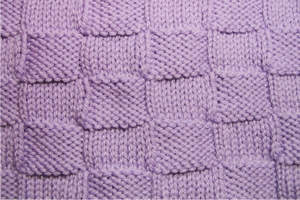The original is inset. The black points in my sketch (graph, really, if we can speak of graphing art!) correspond to the red points in the original. I did the brown (left-facing) swans in brown and the white (right-facing) ones in green. In group theory and music theory, we call these two cycles, or orbits.
It didn't work for a couple of reasons which I'll tweak the next time around. Generally, I wasn't as meticulous as Escher had to be to make this work (to make it obtain, as they say in abstract algebra). Then, I didn't realize the points at the top of the swans' heads should be the exact same distance from the point at the back of the swan's head (corresponding to the nearest corner of a square in my graph) in both directions, because it somehow escaped me that the right- and left-facing swans are identical, just reflected. D'oh.
The other problem is that I only made the squares ten by ten stitches, represented by the smallest units in the graph. This just made it harder to imitate Escher's original swan shapes. It also made the shapes more pixelated, of course. Since Escher's tile shapes are only vaguely realistic to begin with, I need to be as precise as possible to preserve the shapes. Next time I'll do at least twelve stitches to a side, though that will take a lot longer and probably make my eyesight deteriorate faster.
The good news is that we have an equivalent of this is music theory, which is what I have to write a paper on, haha. Basically, the points in the graph (at the intersections of lines) are equated to points in the Tonnetz, which each represent major and minor triads.
The better news is that in knitting, we have the additional property that knitting is the "inverse" of purling, which also has a parallel music: major and minor triads. Invert a major, you get a minor - a very different sound.
So if I do a visually engaging representation of the Tonnetz in the knitting medium, it would look kind of like one of Escher's "tiled" works, consisting of two interlocking cycles of shapes, one right-facing and one left-facing. ("Cycles" in the group theory sense come up a lot in algebraic knitting.) One cycle would be in knits (stockinette stitch), and the other would be in purls (reverse stockinette). Flip it over and you see the same pattern.
This idea of reversible fabrics HAS PRECEDENT IN KNITTING!

This knit is reversible; flip it over and it looks the same. It's also a simple example of a tile pattern:
As with Escher, the pattern repeats both horizontally and vertically.
This is also a property of the Tonnetz ("network of tonal relations"), a two-dimensional model of all the major and minor chords in the diatonic system.

This is actually a bad picture of the Tonnetz because it doesn't reflect enharmonic equivalence: for instance, C sharp equals D flat, C double sharp equals D double flat, etc. The concise Tonnetz is much smaller, without all that redundancy.
See how the patterns (cycles) or major and minor triads resemble the right- and left-facing swans? The major triads always point up, and the minor ones always point down. As in Escher, the two cycles are reflections of each other.
Wanna know something else cool?

This blog can do animations!
No, besides that. You're looking at the 3-D Tonnetz. Since it repeats both horizontally and vertically, it can be represented on the surface of a torus (donut).
You can also knit tori.
To be continued.
+system+IV+D.jpg)
No comments:
Post a Comment